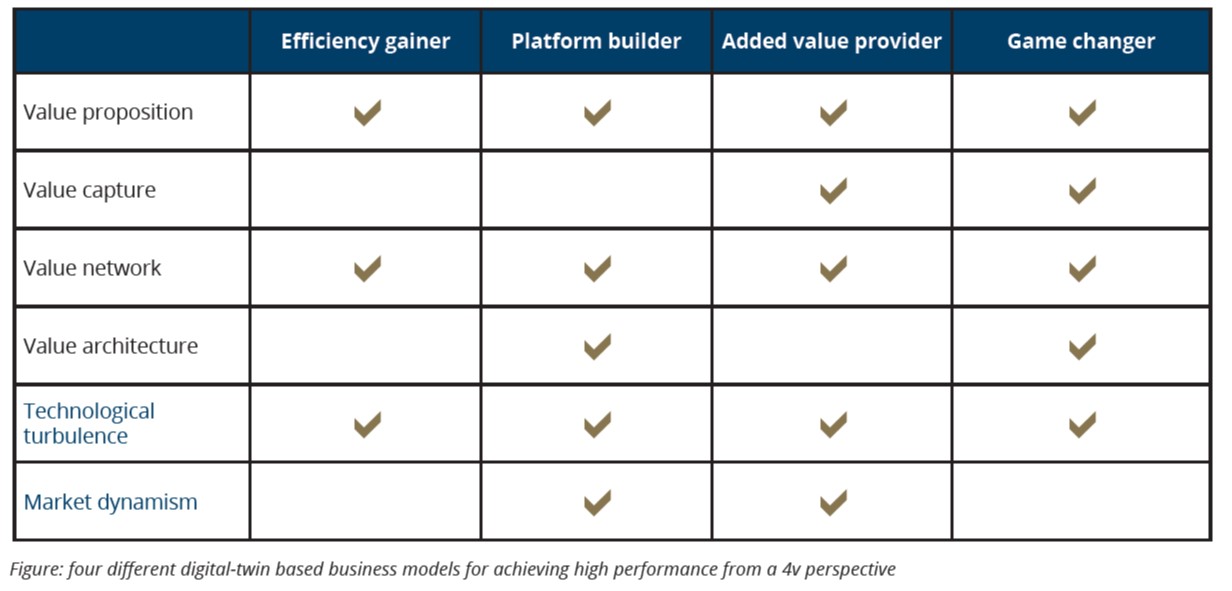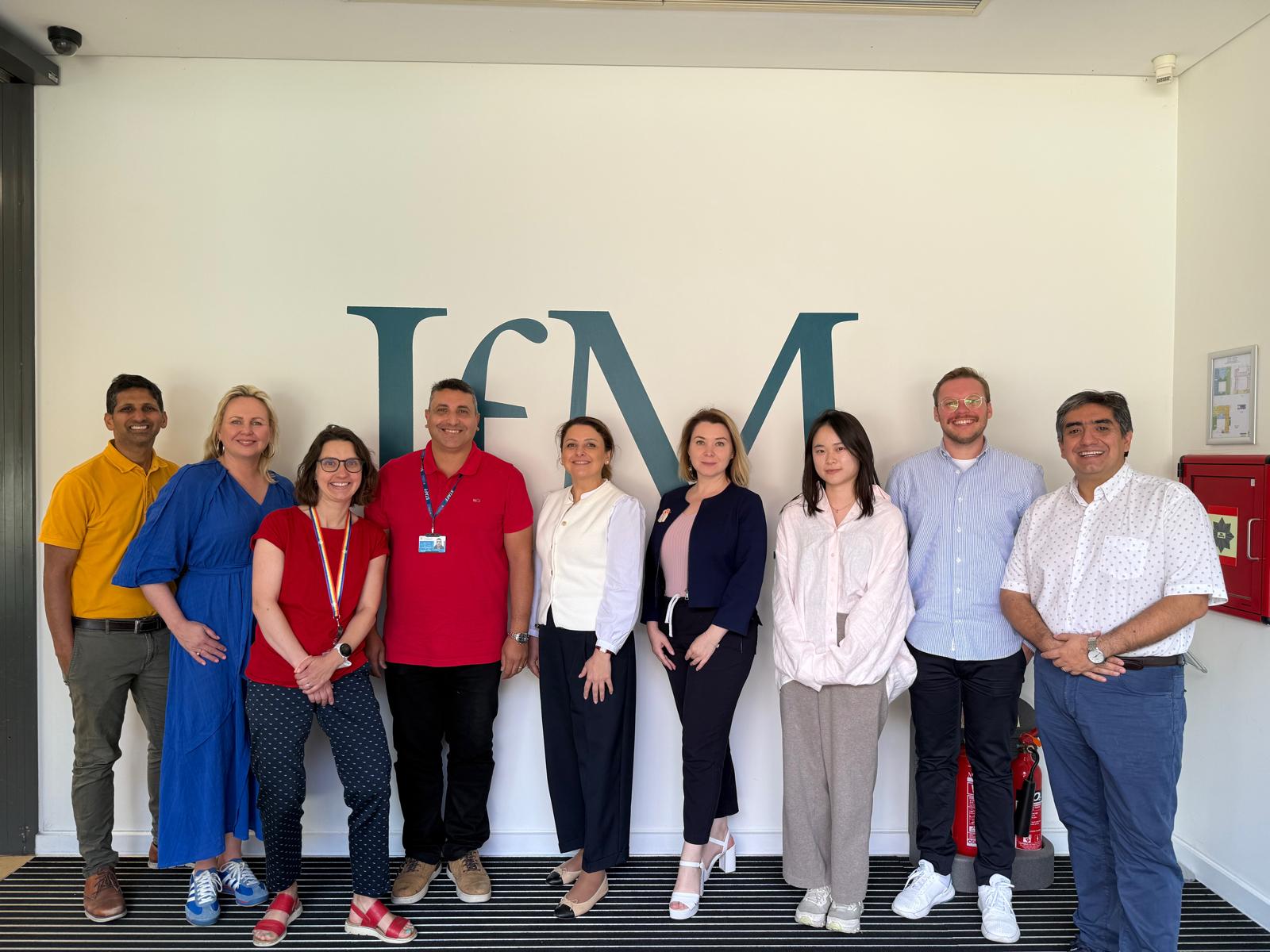
Submitted by C.L. Jenkins on Mon, 20/02/2023 - 15:48
Many manufacturers – particularly asset-intensive manufacturers – are already investing in digital twins. To date, however, academic research has largely characterised digital twins as a means of increasing efficiency, reducing costs or improving existing services, rather than as an opportunity to develop completely new business models. This focus on operational efficiency signals pipeline business thinking rather than a business opportunity mindset.
Our work aims to redress that balance by showing how firms are using digital twins in a variety of different ways to create new services. Through interviews with 30 senior leaders with experience of digital twin implementation in a wide range of business-to-business sectors, we have identified four different routes to business model innovation, each of which can harness the potential of this transformational technology.
By identifying these four different types – and showing how those business models have been configured – we can help executives charged with thinking about the opportunities for digital twins in their own organisations better understand the opportunities they present.
The four ‘values’ of business model transformation
First, we need to define what we mean by a business model. We have used the ‘four Vs’ approach to help us analyse how a business model works, compare different business models in a structured way and help executives systematically design new ones.
- Value proposition defines how an organisation creates value for its customers and other stakeholders.
- Value architecture refers to the technological, organisational, and procedural infrastructures and configuration necessary to enable value delivery.
- Value network is the understanding of connections between organisations and collaborations between a network of parties, organisations, and stakeholders.
- Value capture (or finance) refers to organisations’ approach to costing structure, pricing, and digital twins’ revenue streams.
Examples of digital twins driving business model innovation
In our study, we found compelling examples of how digital twins are underpinning new ways of doing business. For example, an asset heavy company is using digital twin navigation and routing data to sell new services to the commercial yachting market, enabling yacht owners to change course in order to minimise seasickness for passengers. It does this by aggregating digital twin data from ships and contextualising the twin by combining it with real-time weather data.
Another firm started out making digital twins of buildings such as sports complexes and large entertainment venues with a view to improving maintenance services. However, it saw an opportunity to develop an entirely new service where the same models are being used to sell virtual tickets to actual events, offering the customer a vantage point from the digital twin model of a stadium from which to experience the same event from home.
Not limited to real events, these digital twins are now also being planned for virtual concerts and sporting events which can be experienced through virtual reality headsets. By selling both actual and virtual seats to the same event, these venues are able to significantly increase their profits.
At the other end of the spectrum, we encountered some heavy machinery industries and manufacturing firms where a digital twin was largely built-in house with limited connections
to new services and little interaction with a network of actors to stimulate new service offerings. These firms focused on using digital twins to improve resource efficiency rather than exploring new services to customers.
How to build a business model based on digital twins
To better understand how firms build digital twin-based business models and achieve financial success by doing so - we conducted a study combining the 4Vs framework with an analysis of key environmental factors: technological turbulence and market dynamism.
Technological turbulence refers to the rate of technology change in an industry and how well a firm can keep up with it while market dynamism refers to the extent to which customer preferences vary and change over time. The results of this study show that the majority of the firms have reached either the digital twin transformation (28%) or operation phases (31%). In addition, more than half of the firms in the sample aim to leverage digital twins to support both internal objectives
(such as productivity or efficiency gains) and external purposes, such as developing new sources of revenue.
In addition to these insights, we also identified four distinct business model configurations for achieving high performance with digital twins:
- Efficiency gainers: these firms have a clear vision of how to generate value with digital twins and they are able to rely on a strong network of partners. They typically operate in a technologically turbulent industry, in which customer preferences are rather stable. Their digital twin implementation is focused on internal efficiency gains, with no new digital twin-based services yet on offer.
- Platform builders: these firms also know how digital twins can be useful to different stakeholders and they collaborate with multiple network partners. Above and beyond, these firms develop architectures and platforms to integrate customers and partners. They operate in dynamic environments in which technologies and customer preferences change frequently.
- Added value providers: these firms have a clear value proposition and an established network of partners. In addition, they score high on value capture, which indicates that these firms have a clear vision of how to generate new revenues with digital twins. The focus of their digital twin implementation is on creating added value for customers. These firms also operate in technologically turbulent industries in which customer preferences change frequently.
- Game-changers: these firms have a strong value orientation and score high on all 4Vs of the digital twin-based business model. These firms are in a mature digital twin phase and operate in technologically turbulent markets. They tend to use digital twins for both firm-internal purposes such as efficiency gains as well as customer-directed services provision
Putting this into practice
The next wave of digital transformations based on digital twin technology can enable business model innovation across industries from aviation, automotive, information systems and the built environment.
We recognise, however, that barriers to digital twin services and business model transformations remain. These include the scale of investment required in the technology, cyber-security concerns, the cultural acceptance of technology and clear commercial or market needs.
Yet, one of the biggest hurdles, is acceptance or buy-in from senior managers. Our research provides a better understanding of the opportunities for those seeking to invest in digital twins and our 4Vs framework provides a blueprint for those looking to create new services.
The four different business model configurations identified in our analysis represent different routes to achieving high financial performance. There is no single path to success with digital twins. Instead, the four business model types may serve as high-level templates for structuring the business model development process.
Proposing value, capturing value, establishing value networks and building value architectures are important elements of the business model, with each of them requiring specific resources, capabilities and organisational activities. However, our results make it clear that firms do not need to excel in all these areas.
In addition, the insights of the analysis may serve as assessment and monitoring tools for those firms that have already started to implement and use digital twins. They may be useful for firms carrying out internal audits, allocating resources and developing actions plans based on (de) prioritisation of value dimensions (4Vs).
Dr Erika Pärn, Research Associate, University of Cambridge.
Professor Alexander Leischnig, Technische Universität Freiberg
Professor Mohamed Zaki, Deputy Director, Cambridge Service Alliance
Dr Michael Grieves, Executive Director and Chief Scientist at the Digital Twin Institute and International expert in Product Lifecycle Management (PLM)




